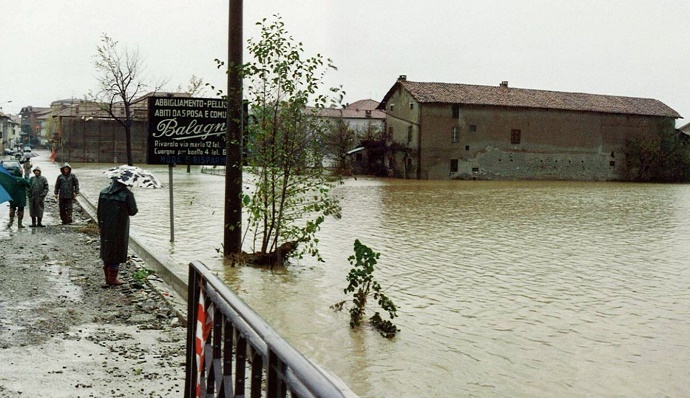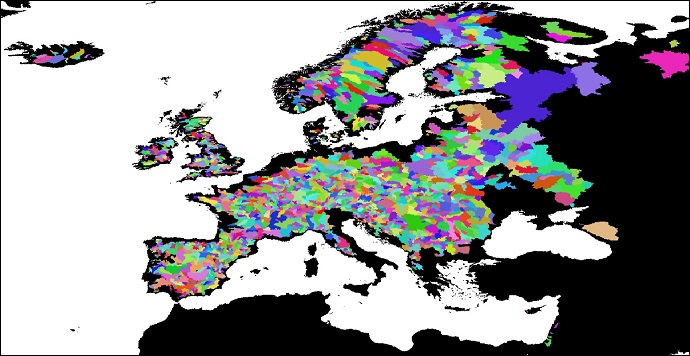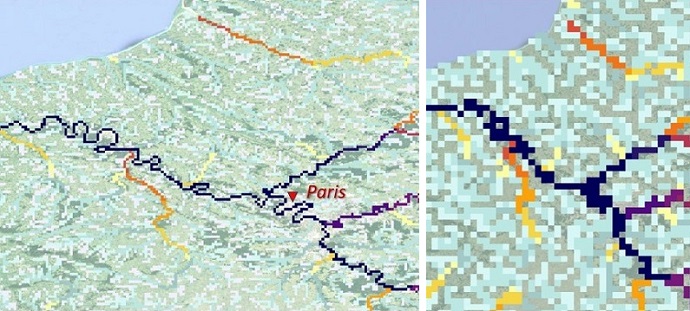

ECMWF takes care of operational matters for the European and Global Flood Awareness Systems (EFAS and GloFAS) of the EU’s Copernicus Emergency Management Service (CEMS). Cinzia Mazzetti uses her hydrological skills to help upgrade EFAS to much higher resolution.
Cinzia’s interest in the destructive power of water was sparked at the age of 11 when she saw the devastation and loss of life caused by the collapse of the Val di Stava Dam in the Italian Alps. “Then, in 1994, there was intense flooding on the river Po, not very far from Bologna, with many casualties, which reminded me of the need to study hydrology,” she says.
At university, she specialised in hydrological modelling as part of a civil engineering course, and took a PhD in environmental modelling, both in Bologna. After working with a private company on the implementation of catchment-scale operational flood forecasting systems for 12 years, Cinzia joined ECMWF in 2017.
She has been busy not just developing EFAS but also working to introduce hydrology into ECMWF’s Integrated Forecasting System (IFS). Her most recent task is to help upgrade EFAS from a resolution of about 5 km to about 1.3 km.

A river flood in northwest Italy on 5 and 6 November 1994 caused 70 deaths and more than 2,000 displaced people. (Photo: Arpa Piemonte, CC BY-ND 3.0 IT)
Updating the hydrological model
Cinzia joined ECMWF as a hydrological modeller for the EFAS and GloFAS teams. Her first job was to work on the hydrological rainfall-runoff model behind the EFAS and GloFAS systems, called LISFLOOD. The model had previously been developed by the European Commission’s Joint Research Centre (JRC).
LISFLOOD uses meteorological, soil and river information to predict the discharge of rivers, including any river flooding. Cinzia’s task was to debug the LISFLOOD code and to help implement the EFAS version released in 2018.
“However, I soon began to co-develop LISFLOOD with the JRC, in particular between 2018 and 2020, when we were working on an EFAS system with higher temporal resolution,” Cinzia says. “LISFLOOD is now open source, so it’s more open to external development.”
She had a key role in the release of EFAS 4.0 in 2020, which increased the temporal resolution of EFAS from daily to 6-hourly.

EFAS 4.0 flood forecast for the Rhine river in Bonn, Germany, on 28 January 2021. Simulated discharge forced with ECMWF's deterministic forecast as the red continuous line and with ECMWF-ENS (ensemble forecast) as box plots. The background colours represent discharge thresholds for 1.5-, 2- and 5-year return periods.
She also led ECMWF’s contribution to PRO NEWS, an EU-funded Programme for Improving National Early Warning System and Flood Prevention in Albania.
For this project, she upgraded EFAS for the area of Albania, including improving the river drainage network, revising parameter sets of LISFLOOD based on new sets of observations, and integrating national monitoring points into the EFAS web interface.
Developing ECMWF’s land model
Cinzia has worked on ECMWF’s Integrated Forecasting System (IFS), too. In particular, she has led the integration of the CaMa-Flood (Catchment-based Macro-scale Floodplain) model, a global-scale hydrodynamic model, into the ECLand component of the IFS.
River discharge is a key component of the global water cycle, integrating meteorological and hydrological conditions on multiple temporal and spatial scales.
“The representation of rivers is of interest for many applications but wasn’t available in the ECLand system.” she says. “With CaMa-Flood we can forecast discharge into rivers as part of the IFS.”
For now, the CaMa-Flood source code has been integrated into the ECLand system, allowing stand-alone CaMa-Flood simulations using one-way coupling: the IFS feeds into ECLand, and ECLand feeds into CaMa-Flood. The two-way coupling between ECLand and CaMa-Flood was also experimentally developed.
“A full integration of CaMa-Flood into the IFS is envisaged in upcoming cycles, but there’s a lot of work still to be done,” Cinzia says.
A new version of EFAS
Meanwhile, Cinzia is working on a substantial upgrade to the current version of EFAS. This involves in particular refining its 5 km horizontal resolution to about 1.3 km. The new EFAS will thus contain nearly 14 times the number of cells it contained before.
“We call it EFASNext, and it’s a major change to be introduced around the end of next year,” she says.
In addition to the much finer resolution, EFASNext includes new static maps to convey information that the model is using. This includes, for example, topography, soil type, land use, channel geometry and river network.
A new calibration will also be performed to adjust the model’s parameters to the new static maps. “It’s not only a change in resolution, it’s a new model,” Cinzia says.

EFASNext calibration catchments.
Just in time for running EFASNext operationally, ECMWF’s new high-performance computing facility (HPCF) in Bologna will become available. But the calibration of the model is still run on the current HPCF.
“This is a very challenging part because we need to split the domain into about 2,000 smaller catchments, and we need hundreds of runs in each one of them,” she says.

Extract of the EFASNext (left) and EFAS 4.0 (right) drainage networks in France. The higher horizontal resolution improves the representation of rivers.
Part of a team
Cinzia is helping her team leader, Christel Prudhomme, to make sure EFAS and GloFAS run as scheduled. She is part of a 16-strong team working across ECMWF on environmental forecasting.
“Whatever I do, I’m not doing it alone!” she says. “EFASNext, for example, would not be possible without the help of ECMWF colleagues from the Forecast and Research Departments, and of course my colleagues in the Environmental Forecasts Team.”
